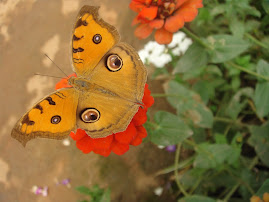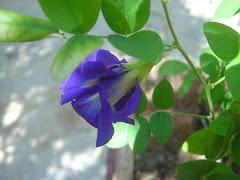
Tina of In the Garden started the 'Signature Plant' series.
Ever since I read that wonderful post it's been on my
mind. After much vacillation between this, that and the
other, I've settled for the Indian Blackberry. Also known
as the Java Plum, black plum, and jambul, it's botanical
name is Syzigium cumini or Eugenia jambolana. It's a common
tree in Asia and native to India, Indonesia and Pakistan. In
my region we call it jam (rhymes with 'calm'). It's commonly
known as jamun in many parts of India.

But before I go into why I've chosen this plant, let's take
a look at it. This is the oldest tree in my garden. All of 14!
Its height is roughly 16ft now but the tree can reach 30mtrs
and live to a hundred years. The wood is used for making
railway sleepers and furniture. The seeds, leaves and bark
have been attributed with many medicinal properties.

By March/April the tree is covered with cream-coloured feathery
blooms.

By June the berries begin to ripen. It's an attractive sight--
green and purple together. And the birds come in flocks...
By July end, and in some cases, till August, the berries remain.

By early November, the leaves turn yellow and start to fall.
A closer look reveals tiny red blotches and on that bright
yellow. In this photo, the fallen leaf has become a refuge
for a dying bee.

On a December morning...the tree never becomes totally bare. I've
read that in dry areas all the leaves fall but here on clayey,
wet ground, it doesn't get any chance!
This is a tree that does not need much care. Growing next to
the wall and the power line, I keep it severely pruned. That's
on the western side. Towards the east I keep no check on its
growth. Our area gets flooded every summer and the water remains
for days. Every year I hope and pray that it survives the rains
and our city's bad drainage. It's still going strong. (Touch wood!)
And when the leaves fall, they go into a bin that I keep next
to the tree. Then months later, the leaf mould goes back into
the soil. Just as I take care of my plants, I feel that in the
same way, the tree's connection to its immediate surroundings
is total. And for all these reasons I've chosen the Indian
Blackberry as my Signature Plant.

And since I recently got pictures of my tree's source, I
thought I'd include them as well. The old tree in my mother's
garden, the one with tree-ferns and other epiphytes. I got the
sapling under this tree when my younger son was a a month old.
I brought the plant to Guwahati in a milk carton!

Old trees have so much character. More tree embellishment here.
The same tree has quite a few ants' nests. They look as if the
leaves are stitched together into basket shapes. This picture
is a little blurry.
Thank you Tina for starting the series. I loved posting this.
Of course I had to keep a check on myself...the tendency to
go on and on.....!!












































.jpg)

































25 comments:
There is always another plant to learn about. Thanks for telling of this one.
Donna
Such an interesting post Kanak. I've learned something new today and I just love all the photos, habits and the origin of your tree. Always such a pleasure to visit with you.
No need to keep check on yourself. I enjoyed the entire post. The tree is fascinating and I too feel that connection you do to them. They are greatest! The Jam tree is beautiful! It is even more special that it came from your mother's garden. I have never heard of this tree but would love one here. It sounds super hardy and rewarding to the gardener. Black plum jam? I'm thinking yummy! The red spots on the yellow leaves are very attractive. It is unique. Thanks for the link love, I have added you to my sidebar. ttyl
Donna, glad to. I find plants from your part fascinating too. Learning through blogs is fun!
Thank you for stopping by.
Thanks Mildred. There's so much to tell and talk about. At times I feel I'm going to burst!:)
Thanks Tina. I forgot to mention the taste of the fruit! It's slightly acidic but really ripe ones are sweet. The juice from the fruit leaves a purplish tinge on the hands and mouth.
In the wild it grows in river banks. I've also come across this bit of info on the web that in Hawaii it's invasive.
Loved your comment! Now I'll go check myself on your sidebar!!
The berries are a lovely color and the leaves remind me of an indoor Ficus tree. Thanks for furthering my tree education today Kanak!!! I always enjoy seeing your world.
Oh yes, the birds go crazy in Jamun season, dont they? You must love them too yourself to carry it with you in a milk-carton all the way to Guwahati!;)
I didnt know they made the railway sleepers with jamun wood... thats interesting!
I've heard they're excellent cure for anaemia, though. What a sweet medicine.
I enjoyed reading about your signature plant (tree) Kanak. Lots of interesting info. to share! It sounds like it produces a wonderful fruit, too! I need to think about what my sig. plant is...I'm still not sure:( Take care!
Susie, the berries are lovely shade of purple. The fruit-bearing season is much anticipated. Glad to know you enjoyed the post.
Oh I do, Sunita. I didn't know about the cure for anemia, glad you mentioned it. But I do know that the seeds are used for treating diabetes. The wonders of Ayurveda!
Jan, it took me a long time to decide what my signature plant would be. It was always on my mind but now that it's out there, I'm happy I did it. I'm looking forward to yours. Cheers!
Ah! I've never known so much about this plant, but have always lives its fruits. Jaaamuuuun! I love it's strange taste. In fact it is after this plant that the island (in which India is a part) we live in is named after - Jambu-dvipa. Great choice, Kanak.
this is quite a question to answer! Love your choice, the detail, and how it relates! Great post:)
{and you were brought home as a sapling, and look how you've grown with tender love and care:}
Chandramouli, that's so interesting! I wasn't aware of jambu-dvipa. Thanks for the info.
Carla, thank you so much! It helped that it came from a no-fuss family. I remember reading an article about portulacas where it was written---if you forget to water it, it'll forgive you. I'd say the same for this tree. Forgiveness is its virtue!
What a great choice for your signature plant Kanak. I've never heard of this tree so thanks for sharing the photos and info with us. Looks like it a wonderful addition to your garden. :)
Thanks for telling us about your tree. It is new to me. How nice that the sapling came from your mother's tree - the connection makes your tree extra special!
Wonderful post. Are the berries edible? As a child in Trinidad there was a jamoon tree with edible purple berries.
thanks kh for sharing your signature plant/tree. the berries are beautiful and the fluffy blooms really cool.
I love the story of your special tree. I can see why it draws you. Thank you for sharing all those interesting little tidbits about the Indian blackberry and the pics too.
What a wonderful legacy for your children, Kanak! The fruit of your tree look a little like ripe olives. I'm curious about those ants. Are they interested in just the leaves, or are they keen on the fruit too?
That was beautifully written, and from what you said, the tree is a great fit to be your signature plant. You are very much tied to the earth.
Racquel, thanks. It really is--that wonderful addition, I mean.
True, Easygardener. Reminds me, our papers carried stories and photos of heavy snow in England. It made me think about your garden covered in it.
Very much so Nicole. You're talking about the same tree.
Thanks for stopping by.
Marmee, happy to read your comment. Glad you stopped by.
Thanks Wendy. It was fun doing this post.
W2W, it is believed that these red ants take care of all kinds of other worms/bugs and the berries remain unharmed and sweet. They're supposed to be good for the tree.
When the tree was younger, my mother got ants from another tree( not berry) and put them on the jam tree.
I haven't come across this info elsewhere but beliefs that have survived generations are well worth a try. That's what my parents say. There's no damage to the fruit as such.
I'm glad you liked the post.
Sue, thank you so much! Touched by your words.
Love this post and your tree, had never heard of it but that's quite a story about you bringing it from your mom's amazing garden to grow up with your baby, now young man. The leaves remind me a tiny bit of olive, as do the berries. Maybe you should submit it to the next Festival of the Trees! Current one is here: http://www.treeblog.co.uk/viewpost.php?id=225
Nice post on the jamun tree! Beautiful pics. I believe, the fruit has astringent properties. So, it's a boon to set the upset- after-gorging-on-mangoes tummies right!
Shailaja
Hi Kanak, I loved hearing about your blackberry tree and thank you for giving the pronunciation too! The best part was hearing about how you brought your tree from your mother's fabulous garden in a carton, that is what gardening is all about IMHO.
Frances
Thanks Karen, for your kind comment, and for telling me about the website. I'll check it out.
True, Shailaja. And so happy to read your comment. Thanks. I didn't realise that our common backyard trees had so many medicinal properties till I started blogging. Glad you mentioned the astringent bit.
Frances, when I actually brought it I never imagined that one day I'd write about it!! Thank you for your comment about my mother's garden. And for stopping by.
Thanks for sharing your wonderful story. The more I read of others signature plants the more uncertain I become in choosing my own. Everyone has such fantastic choices.
Hi Jill-O, yours will be too! Would love to read your post! And thank you for your visit.
Post a Comment